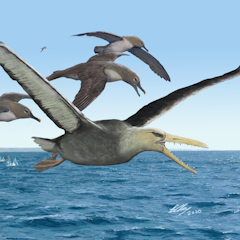
Articles on Cretaceous period
Displaying 1 - 20 of 33 articles

Oceanic dispersal of dinosaurs between Europe and Africa shows how low-probability, high-impact events drive evolution.

Fossils suggest that as many as three abelisaurid species coexisted in Morocco around 66 million years ago.

Rather than a juvenile of a known species, several fossilized bones represent a new species – and shed light on the question of whether dinosaurs were already in decline before disaster struck.

Scientists have discovered a new species of mosasaur, a sea-dwelling lizard from the age of the dinosaurs, with strange, ridged teeth unlike those of any known reptile.

The most detailed evolutionary tree of butterfly species ever created reveals the precise origins of the nectar-sipping gadabouts.

The Wapiti Formation in Alberta is turning out to be a rich site for dinosaur and other fossils. A recent discovery could fill in the gaps about a transition between different ecological communities.

Yes, dinosaurs really did survive in snow – we simulated the Cretaceous climate to prove it.

A recent BBC documentary examined fossils thought to have been made when an asteroid wiped out the dinosaurs.

Two recent discoveries in Alberta and Uzbekistan have identified the top predators in those regions during the Cretaceous period. Fossils that had been in storage for years included the jawbones.

While crocodiles are not native to Canada, fossil traces have been found in northern British Columbia that indicate that during the Cretaceous Period, giant crocodiles roamed.

A recent study provides additional evidence that the dinosaurs died in June.

We examined pterosaur jaw fragments from the Moroccan desert to understand more about how these creatures evolved.

Ever since moviegoers saw the first ‘Jurassic Park,’ millions have wondered if scientists could make a dinosaur in the lab.

Australotitan was a massive long-necked sauropod estimated to weigh the equivalent of 1,400 red kangaroos.

The recent discovery of fragments of a jaw fossil show that at one point, herbivorous reptiles evolved highly complex and efficient teeth.

Preserved in amber, a tiny beetle has shed light on the moment the world first burst into bloom.

Tooth fossils from NSW have confirmed sauropods weren’t exclusive to Queensland. They’re also providing a first look at how these colossal dinosaurs fed from Australia’s land.

Paleontologists have discovered fossil remains belonging to an enormous ‘toothed’ bird that lived for a period of about 60 million years after dinosaurs.

Our new research has discovered how a series of volcanic eruptions 233 million years ago fundamentally changed life on Earth.

Twenty-two years ago, President Clinton established Grand Staircase-Escalante National Monument for paleontological conservation. As the Trump administration shrinks its borders, that mission is jeopardized.
